Flow Cytometer: Difference between revisions
m (→Educationz) |
No edit summary |
||
| Line 25: | Line 25: | ||
There are a number of large external units some of which are for providing power and cooling to the large laser. (I do not anticipate that the largest laser will be tested for some time, so I hope to move these into out-of-the-way storage, under the worktop in the biolab) | There are a number of large external units some of which are for providing power and cooling to the large laser. (I do not anticipate that the largest laser will be tested for some time, so I hope to move these into out-of-the-way storage, under the worktop in the biolab) | ||
There is a good description of how a flow cytometer works here; http:// | There is a good description of how a flow cytometer works here; http://media.invitrogen.com.edgesuite.net/tutorials/4Intro_Flow/player.html | ||
It was donated as working, but in need of repair. There is quite a lot of damage due to corrosion, and to the sampling area which we are working on. | It was donated as working, but in need of repair. There is quite a lot of damage due to corrosion, and to the sampling area which we are working on. | ||
| Line 54: | Line 54: | ||
This is a AV presentation describing the basics of the technology; | This is a AV presentation describing the basics of the technology; | ||
http:// | http://media.invitrogen.com.edgesuite.net/tutorials/4Intro_Flow/player.html | ||
Revision as of 10:35, 27 November 2013
Imperial College donated a Flow Cytometer. The unit is currently sitting on 1.8m X 0.8m = 1.44 square meters of floor space in the PCB area of the basement.
Status: Currently waiting for basement plumbing to complete, before proceeding with fixing the fluid-assembly at the front right of the instrument. It needs a dust cover, or some protection to access the laser cabinet.
There are a number of large external units some of which are for providing power and cooling to the large laser. (I do not anticipate that the largest laser will be tested for some time, so I hope to move these into out-of-the-way storage, under the worktop in the biolab)
There is a good description of how a flow cytometer works here; http://media.invitrogen.com.edgesuite.net/tutorials/4Intro_Flow/player.html
It was donated as working, but in need of repair. There is quite a lot of damage due to corrosion, and to the sampling area which we are working on.
The machine requires a dust free environment due to it's use of lasers and optics.
I am currently looking to obtain a copy of the service manual.
Educationz
Harvard University extension school course on microfluidics, course notes
http://isites.harvard.edu/icb/icb.do?keyword=k41912&pageid=icb.page213804
Caltech course notes on microfluidics
http://thesis.library.caltech.edu/4796/3/02_Chapter_2.pdf
Cornell book on microfluidics
http://www.kirbyresearch.com/index.cfm/wrap/textbook/microfluidicsnanofluidics.html
Flow cytometry tutorial
This is a AV presentation describing the basics of the technology;
http://media.invitrogen.com.edgesuite.net/tutorials/4Intro_Flow/player.html
Practical Flow cytometry
This is an online version of the bible of Flow cytometry (Shapiro 2003)
http://www.coulterflow.com/bciflow/practical/book/index.html
Dako - flow cytometry
http://www.dako.com/08065_15dec05_guide_to_flow_cytometry.pdf
Microfluidics Links
Introduction to fluidics
